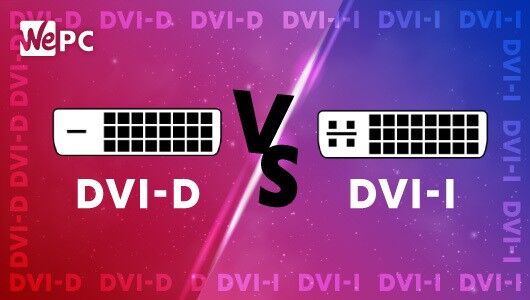DVI-I vs DVI-D – what’s the difference, and which one is better?
A quick look at the main features of both DVI-I and DVI-D connectors

WePC is reader-supported. When you buy through links on our site, we may earn an affiliate commission. Prices subject to change. Learn more
DVI-I and DVI-D connectors have been used with modern displays and graphics cards for years, offering a digital interface for connecting the two devices together.
Despite being grossly outdated (with both HDMI and DisplayPort offering better efficiency and performance), you’ll still see both interfaces used in today’s market – albeit on aging hardware.
For that reason, we’ll be exploring some of the fundamental differences that separate DVI-I and DVI-D. Which one should you use? Which is better for your display needs? And should you just use HDMI? Let’s find out.
DVI – what is it, and what does it do?
Before diving into the differences between the two standards, let’s explore exactly what DVI is.
DVI connectors are used for connecting modern displays (LCD monitors or projectors) to a graphics card. DVI connectors are often colored white (unlike VGA connectors, which are blue) and feature a formation of pins that varies depending on the specific DVI connector you plan to use. Two screws can be found at the side of each DVI connector to help secure it in place during usage.
The DVI connector utilizes a digital protocol that transfers the illumination of pixels as binary data. When using a panel in its native resolution, the DVI connector will transfer each number and allow the monitor to apply the correct brightness to the appropriate pixel.
While DVI connectors are becoming outdated, some individuals still utilize them for their display needs.
Types of DVI connectors
To help confuse the situation further, there are several different variations of DVI connectors. In total, you can narrow the variations down to three primary options: DVI-I, DVI-D, and DVI-A. Each of the DVI variants offers a unique set of transfer features that make some more useful than others.
In terms of popularity, DVI-I and DVI-D are much more common than DVI-A. In fact, DVI-A was rarely used back when DVI connectors were most popular. The DVI-A connection can only transfer analog signals.
DVI-D
The ‘D’ here stands for ‘digital’ – and just like the name suggests, this connector deals only with digital signals. Of course, leveraging the digital signals, with this connector, you can get higher resolution and better image quality. Another advantage here is that the DVI-D connectors can be used with DVI-I ports as well.
DVI-I
The DVI-I connectors are more flexible than the DVI-D and DVI-A connectors – because they can carry both analog and digital signals. So, if you have older devices and need backward compatibility, then a DVI-I cable can be a suitable option. The DVI-I cables do not transmit both signals at once – the device picks a signal based on compatibility.
DVI-A
The ‘A’ here is for Analog, which is indicative of the analog signals it exclusively transmits. As you can guess, the DVI-A cables are considered outdated, and the resolution is limited to 1920×1080.
DVI-I vs DVI-D compared
Along with DVI-D and DVI-I, we have also added DVI-A in this section. Below, you can clearly see the differences between all five DVI connections –
As DVI-A is considered outdated, most people would reach for a DVI-I or DVI-D connector. As you might know, the two are slightly different and both have single and dual link formats, which add to the confusion. To make understanding simpler, we have illustrated the difference in performance right here –
Frequently Asked Questions
What’s the main difference between DVI single-link and dual-link?
The main difference that can be found when comparing DVI single-link and dual-link (regardless of DVI type) is the max bandwidth that they support.
Roughly speaking, a single-link DVI interface offers up to around half the bandwidth of a dual-link connection. How does this affect its performance? Well, the additional bandwidth found in dual-link variants allows for a greater maximum resolution – as seen in the table above.
A single-link DVI-I or DVI-D connector can transfer a maximum of 3.96 Gbit/s, resulting in a maximum resolution of 1920 x 1200 at a maximum refresh rate of 60Hz. Dual-link, on the other hand, offers support for up to 7.92 Gbit/s that can support up to 2560 x 1600 max resolution. Unfortunately, no DVI connector has the available bandwidth to support 4K in any capacity.
What’s the difference between digital and analog signals?
Well, apart from one being digital and one being analog, the main difference lies with what monitors they support. Analog signals were more commonly used when CRT monitors were the dominant force in the market. Fast forward to 2022 and modern digital LCD monitors aren’t supported by the same analog connections.
As LCD monitors became more prevalent, DVI-I connections were then utilized as they could carry the digital signal used by these modern panels.
Conclusion
So, there you have it, our quick guide to the fundamental differences between DVI-I and DVI-D. Ultimately, when you take away the fact that one can transfer both analog and digital signals (why the other can only transfer digital), there isn’t a great deal of difference between the two.
The glaring issue for both variations of DVI is that the technology is rapidly aging, and many of today’s GPUs (and displays) don’t actually support the interface. It’s quite literally fading out, and soon, there will be no real-world requirement for the display interface – unless you plan on using your CRT monitor for the foreseeable future (which I’m not against).